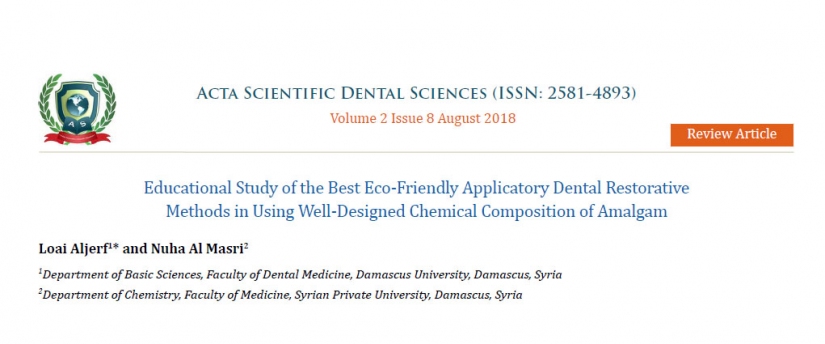
Educational Study of the Best Eco-Friendly Applicatory Dental Restorative Methods in Using Well-Designed Chemical Composition of Amalgam
Published in:
Acta Scientific Dental Sciences (ISSN: 2581-4893), , Volume 2 Issue 8 August 2018
Authors:
Loai Aljerf and Nuha Al Masri
Abstract:
Objective: Tooth decay is a common problem affecting both children and adults. Cavities form in the teeth by the action of acid producing bacteria present in dental plaque. A number of techniques and a variety of materials can be used to restore teeth and one of the most commonly used and comparatively cheap filling material is dental amalgam (a mixture of mercury and metal alloy particles). So, we came to assess the effects of the physical and the chemical impacts as the adhesive bonding on the in-service performance and longevity of restorations of dental amalgam including the effects of certain polishing instruments on the surface
hardness of this material.
Methods: Amalgam restorations have been accomplished and accurately are carved using a systematic technique. To avoid marginal infiltration, the amalgam was burnished immediately after the cavity is filled. Besides, clinical factors affecting residual basic metals as mercury and marginal adaptations of amalgam restorations were investigated. The effect of moisture in zinc-containing amalgams was also studied.
Results: There is no evidence to either claim or refute a difference in survival between bonded and non-bonded amalgam restorations;
in addition, amalgam bonding has eliminated the unnecessary removal of sound tooth structure during cavity preparations.
Burnishing has disturbed surface crystallization, bringing an excess of mercury to the surface, with the possibility of weakening and
susceptibility to tarnish and corrosion on the particular surface. The use of mercury-rich amalgam has significantly improved the fracture toughness; however, it is removed quickly before it “seeps” back into the condensed mass. Gold foil resists the penetration of the condenser nib and protects the fragile, brittle enamel walls, but amalgam in its plastic state is incapable of this, and the possibility of shattering the enamel walls can lead to flaws developing at enamel margins. The amount of saline and zinc in the amalgam specimens has produced no perceptible differences in the amount of expansion.
Conclusion: Well-adjusted chemical composition and thermal preparation (lower than 65° C) of dental amalgam are the paramount for restorative material especially
Keywords:
Filling Material; Tooth Structure; Residual Mercury; A.D.A. Specifications; Metamorphosis; Hydrogen Gas
Links:
actascientific.com/ASDS/pdf/ASDS-02-0282.pdf
Syrian Private University - medicine @ 2024 by Syrian Monster - Web Service Provider | All Rights Reserved